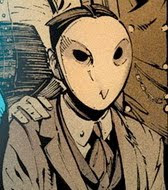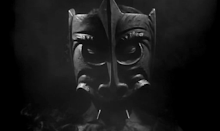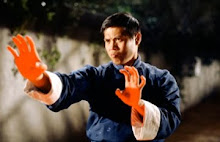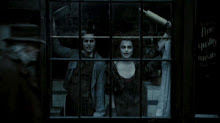After 5 years and 40
densely imaginative issues Locke & Key is drawing to a close on Wednesday. And I'm going to lose my monthly dose of literary smack.
So in tribute to what has been for my money the best book on the racks for over the last half decade. I want to do a little something different. Rather than look back on the highlights of the run I think I'll let you discover them for yourself.
But Locke & Key also offers a puzzle of another sort. Hill is a
novelist and has peppered Locke & Key
with all sorts of literary references. Some are fun tributes, others offer
hints to the mechanics of Hill’s world offered nowhere else in the text, some might hint at whatever end is coming tomorrow. Here
are a few of the more prominent ones.
H.P. Lovecraft: Locke & Key follows three siblings,
Tyler, Kinsey and Bode, who move with their Mother from California to their
ancestral home of Lovecraft, Maine in the wake of a family tragedy. There they
find themselves heir to their family legacy, a series of reality bending keys.
If you are in a horror story there are few worse ideas than moving to a place
called Lovecraft Maine. Perhaps only Satansberg, OH and
That-Place-Where-All-Those-Camp-Counselors-Were-Butchered, TN can compete.
The Lovecraft influence
actually lay dormant for most of Locke & Key’s run as the book
developed its own intricate mythology. But the Lovecraft DNA reared its head
with a vengeance in the first issue of the Clockworks arc, “The
Lockesmith’s Son”. Revealing (via a fantastic Drag Me To Hell reference)
that the mysterious Black Door buried beneath the ancestral Locke home leads to
the Lovecraftian Gods, the Great Old Ones. Making it approximately the 798th portal to the Great Old Ones that protagonists in horror fiction
have stumbled upon.
I have mixed feelings
about Hill making the Lovecraft connection explicit- well explicter. On one
hand it’s not the first time Hill has used the device, his novella “Voluntary
Committal” hinged on a similar reveal. But as Lovecraft himself noted, “…the
oldest and strongest kind of fear is fear of the unknown" and ironically
Lovecraftian horror has become a very well known quantity. Hill’s homebrewed
mythology was up until that point not. Which brings us to…
N0S4A2: In Hill’s latest (and absolutely phenomenal)
novel, N0S4A2 the Locke Family makes a cameo on a list of Inscapers. N0S4A2
was an ambitious book, among other things it ties Hill’s previous work into one
cohesive universe using the concept of Inscaping.
To simplify, Inscaping
is the power to make imaginary things real, or to be more precise, the ability
to bring the things inside of your head into the real world, whether they’re
actual physical things or abstract concepts (such as when Kinsey Locke first
removed and then imprisoned her capacity for grief and fear). Hill uses the
Head Key to literalize the process, which allows characters to physically open
the mind and access whatever is within it.
Inscapers can be
benevolent or malevolent but all eventually pay a great price for the use of
their ability. The Lockes are no exception.
Bill Waterson: In one of the oddest stand alone issues, the
first issue of Keys To The Kingdom, “Sparrow”, found Gabriel Rodriguez
drawing almost the entire issue in the style of Bill Waterson. It tells the
story of youngest Locke sibling, Bode, as he uses the keys to explore the
wilderness, recruiting a flock of sparrows in the fight against the evil
stalking the family.
What at first seems like
an out of left field choice pays off brilliantly, utilizing Waterson’s
signature style to bring the New England winter woods to starkly beautiful
life. A simple, unshowy mastery and respect for nature and wildlife were always
a hallmark of Watterson’s art. It’s put to beautiful use here, as is the
emotional transparency of Watterson’s signature character style.
But the true brilliance
of the reference comes at the end of the story. After all what is such a
situation for a child than one of Calvin’s daydreams come to life, with the
stakes risen to terrible proportions.
Ray Bradbury: Bradbury is one of Hill’s biggest, yet least
cited influences. Hill has played with Bradburyian conventions before. His
first published collection, 20th
Century Ghosts, featured the short
story “Last Breath” which could have come straight out of The October Country.
He also contributed “By The Silver Water Of Lake Champlain” to the collection
of Ray Bradbury tributes, Shadow Show.
The Locke & Key
standalone “Open The Moon” finds Hill once again trying on Bradbury’s voice for
size (the issue is dedicated to him). Exploring Bradbury’s style at his most
wistful, “Open The Moon” tells the story of a Locke ancestor’s attempt to use
the keys to create a refuge for his terminally ill son.
The story is true to
Bradbury’s voice, paying tribute to his singular ability to blend whimsy and
sentiment with melancholy, to take the awareness of the omnipresence of death
and to use fantasy to disarm it.
The Tempest: But by far the text most central to Locke &
Key is The Tempest. The image of the Shakespeare play performed with
real magic is introduced in “Intermission” the first issue of Headgames,
arguably the best issue of the entire run. It’s an event returned to time and
again, the lynchpin that sealed the fate of the Locke family.
Echoes of The Tempest
can be seen across Locke & Key. Like The Tempest, Locke
& Key is about a child (or in this case children) kept in ignorance of
their legacy by their parents. It also doesn’t take much to connect The
Tempest’s magical character Ariel, sealed in a pine, to the main antagonist
of Locke & Key the demonic Dodge who begins the story sealed in a
well.
But I am most interested
in how The Tempest might hint at the
ending of Locke &
Key. The Tempest ends with Prospero, a practicing sorcerer, drowning
his book of spells. Given the handy grotto beneath Keyhouse, where several of
the principles are now trapped, it’s possible that the story might end with The
Locke children drowning their keys.
However, it is possible that another, darker,
meaning is hinted at by the reference to The Tempest. After all among
the play’s most famous lines is the phrase, “Hell is empty and all the devils
are here.”
...
If you REALLY want to hear me geek out about Locke And Key (and other things Joe Hill) over an extended period of time, be sure to check out my book Son Of Danse Macabre, available on The Kindle and Nook. 2.99 Cheep!
If you REALLY want to hear me geek out about Locke And Key (and other things Joe Hill) over an extended period of time, be sure to check out my book Son Of Danse Macabre, available on The Kindle and Nook. 2.99 Cheep!










































































































4 comments:
I recently read volumes 1 through 4 of Locke and Key on your recommendation, and wasn't disappointed. Some of the best graphic novels I've ever read. I'm looking forward to reading the final two volumes.
This is my first time i visit here. I found so much entertaining stuff in your blog..
Govt jobs
The post was awesome I really feel energetic to view your Post.the Post seems to be colourfull and attractive.Myrtle Beach condos for sale
I really liked your article and posting your picture as it is very interesting to read thank you
Buy Instagram Followers
Post a Comment